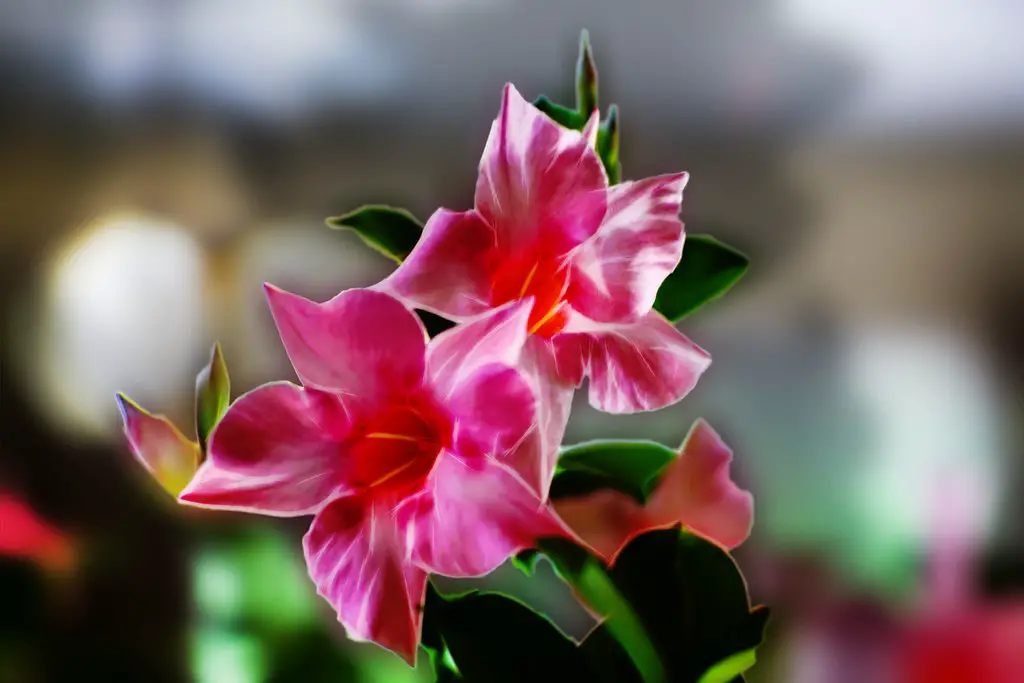Dipladenia, also known as Mandevilla, is an evergreen climber that graces gardens and patios with its vibrant trumpet-shaped flowers. Renowned for its tropical allure, the plant displays bold blossoms in shades of pink, red, or white, accompanied by glossy green foliage. Originating from Central and South America, Dipladenia thrives in warm climates and can add a splash of color to any setting.
Although commonly found outdoors, Dipladenia can also be grown as an indoor houseplant, where it brings a touch of the tropics to living spaces. Growing up to 8 feet tall, this perennial can be trained to climb on trellises or cascade from hanging baskets. Its ability to bloom for an extended period throughout the summer months has made Dipladenia a popular choice among gardeners and plant enthusiasts.
With proper care and attention, Dipladenia can become a thriving centerpiece in gardens or homes. Its hardiness and low maintenance requirements make it suitable for both novice and experienced gardeners. The plant’s elegant appearance, combined with its versatile nature, ensures that Dipladenia remains a beloved favorite in many horticultural circles.
| Attribute | Details |
|---|---|
| Common Names | Dipladenia, Mandevilla |
| Botanical Name | Mandevilla spp. |
| Family | Apocynaceae |
| Plant Type | Evergreen climber |
| Mature Size | 4-8 feet tall |
| Sun Exposure | Full to partial sun |
| Soil Type | Well-drained, sandy soil |
| Hardiness Zones | 10-11 |
| Native Area | Central and South America |
Dipladenia Care
Caring for Dipladenia is relatively straightforward, and the plant is known for its adaptability. It flourishes in full to partial sunlight, favoring well-drained soil with a slightly acidic pH. Proper watering is essential, with care taken to avoid waterlogging the soil, as this can lead to root rot.
Fertilizing every two weeks during the growing season with a balanced liquid fertilizer will promote lush growth and flowering. Pruning is required to maintain shape and control size, and this can be done in late winter or early spring. As a tropical plant, Dipladenia requires warm temperatures and may need to be moved indoors in regions where frost is a concern.
Light Requirement for Dipladenia
Dipladenia requires full to partial sunlight. Providing at least 4-6 hours of direct sunlight per day will ensure vibrant blossoms and healthy foliage.
Soil Requirements for Dipladenia
Well-drained, sandy soil with a pH level of 6.0 to 6.7 is ideal for Dipladenia. Heavy or compacted soil should be avoided, as it can lead to poor drainage and root problems.
Water Requirements for Dipladenia
Regular but moderate watering is necessary, especially during hot weather. Allow the top inch of soil to dry between waterings to prevent overwatering and root rot.
Temperature and Humidity
Dipladenia thrives in temperatures between 60-80°F (16-27°C) and prefers high humidity. It is not frost-tolerant and must be protected or moved indoors during colder months.
Fertilizer
A balanced liquid fertilizer, preferably one formulated for flowering plants, should be applied every two weeks during the growing season.
Pruning Dipladenia
Pruning can be done in late winter or early spring to maintain shape and control size. Dead or damaged stems should be removed, and the plant can be shaped according to preference.
Propagating Dipladenia
Dipladenia can be propagated through stem cuttings. Cuttings should be taken from healthy, non-flowering stems and rooted in a mixture of perlite and peat moss.
How To Grow Dipladenia From Seed
Growing Dipladenia from seed is a lengthy process and is generally less common. Seeds should be sown in well-drained soil and kept in a warm, humid environment.
Common Pests & Plant Diseases
Aphids
Aphids can be a concern and may be controlled with insecticidal soap.
Root Rot
Avoid overwatering and ensure proper drainage to prevent root rot.
Common Problems With Dipladenia
Leaf Yellowing
This may be caused by overwatering or nutrient deficiencies. Check watering habits and consider adjusting fertilization.
Lack of Blooms
Insufficient sunlight or incorrect fertilization may lead to a lack of flowers. Ensure adequate sun exposure and proper fertilization.
Pro Tips
- If growing indoors, provide ample sunlight or supplement with grow lights.
- Consider using a trellis or support to guide the growth of climbing varieties.
- Water sparingly in winter, as the plant enters a dormant phase.
- Use a humidifier or misting to maintain humidity if growing indoors.
- Monitor for pests and address issues promptly to prevent spread.




